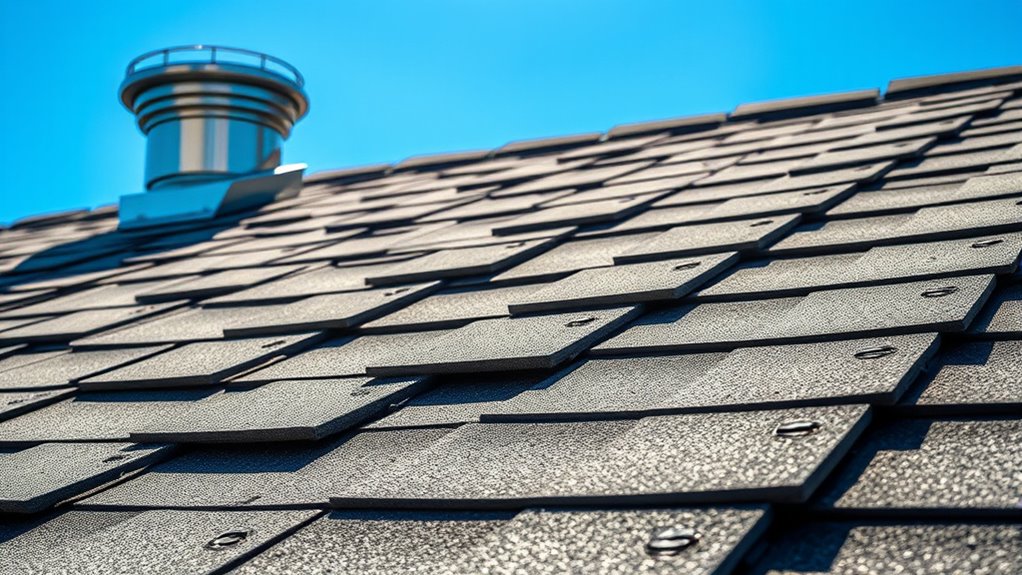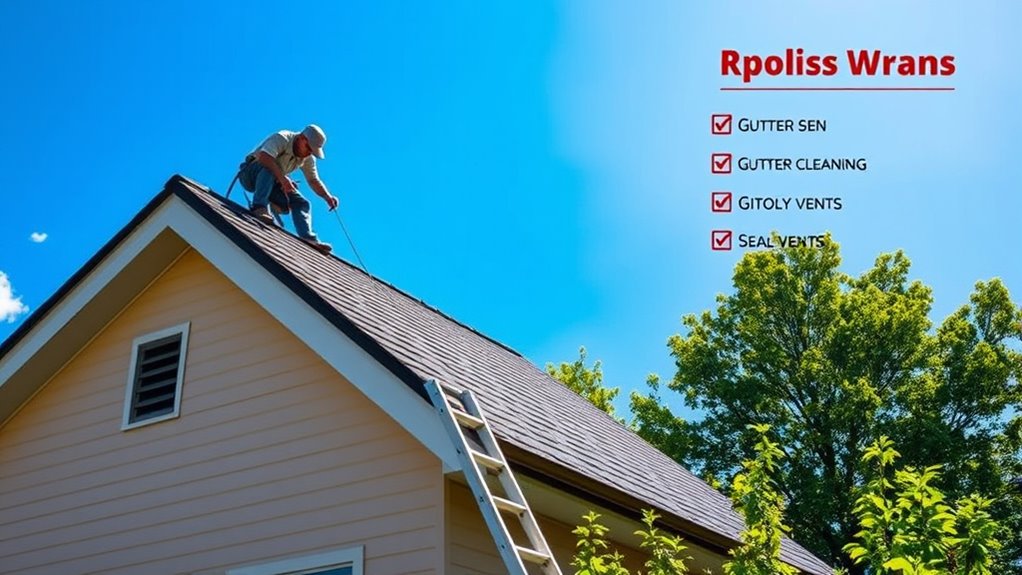To prevent summer leaks, regularly clean your gutters and downspouts to remove leaves and debris. Trim overhanging branches to prevent damage and blockages. Check and repair flashing and roof penetrations for leaks. Inspect shingles and roofing materials for cracks or damage. Clear moss and debris from the roof surface, and guarantee proper ventilation and insulation. Staying on top of these tasks helps keep your roof in top shape—keep going to learn more about each step.
Key Takeaways
- Regularly inspect and clear gutters and downspouts to ensure proper drainage and prevent water backups.
- Check for damaged or missing shingles, especially around roof penetrations, and repair promptly.
- Ensure roof flashing and seals around vents, chimneys, and skylights are intact and properly sealed.
- Improve attic ventilation with ridge or soffit vents to reduce moisture buildup and heat stress.
- Schedule professional inspections before storm seasons to identify and address potential leaks early.
Inspect and Clean Gutters and Downspouts

Regularly inspecting and cleaning your gutters and downspouts guarantees that water flows properly away from your roof and foundation. Proper gutter installation ensures that water is directed efficiently, preventing leaks and damage. During your inspection, check for clogs caused by leaves, dirt, or debris, and remove any blockages. Pay close attention to the downspout design; ensure they are securely attached and free of dents or obstructions that could impede water flow. Clear out all debris using a scoop or hose, and flush the system to verify proper drainage. Well-maintained gutters and downspouts protect your home’s structure and help prevent costly repairs. Making this a routine task keeps your roof in good shape and ensures rainwater is effectively diverted away from your foundation. Additionally, ensuring the resale value of your home remains strong can be supported by diligent roof and gutter maintenance.
Trim Overhanging Branches and Vegetation

Trimming overhanging branches and vegetation helps prevent roof damage from falling limbs. It also stops debris from accumulating on your roof and reduces the risk of pests making a home there. Taking care of these issues now can save you time and costly repairs later. Regular inspections can help identify wear and tear on your roof and prevent small issues from becoming major problems.
Prevents Roof Damage
Overhanging branches and nearby vegetation can pose a serious threat to your roof if left unchecked. During storms, they increase the risk of hail damage by providing a pathway for hailstones to strike your shingles directly. Overgrown branches can also weaken your roof’s wind resistance, making it more vulnerable to wind damage. When branches scrape or fall onto your roof, they can cause cracks or punctures that lead to leaks. Removing these branches reduces the chance of debris causing damage during storms and helps your roof withstand high winds better. Regularly trimming overhanging trees and vegetation is an essential step in preventing roof damage, keeping your home protected, and extending the lifespan of your roof. Additionally, automation in business technologies can assist in scheduling regular maintenance and inspections to ensure ongoing roof integrity.
Stops Debris Accumulation
To prevent debris from accumulating on your roof, it’s essential to remove overhanging branches and nearby vegetation. This minimizes leaf debris, bird nests, and other materials that can clog gutters and cause leaks. Trim back branches that hang directly over your roof to reduce the chance of falling leaves and twigs. Regularly inspect your trees for bird nests, which can block vents or damage shingles if disturbed. Additionally, understanding color accuracy in your roofing materials can help you choose the best protective coatings to resist staining and weathering.
Consider these steps:
- Remove fallen leaves and twigs promptly to prevent buildup.
- Trim overhanging branches to avoid continuous debris fall.
- Check for bird nests and relocate them if they pose a risk of damage or blockage.
Taking these actions keeps your roof clear and reduces the risk of potential leaks caused by debris accumulation.
Reduces Pest Risks
Ever wonder how overgrown branches can invite pests to your roof? Trimming overhanging branches and nearby vegetation reduces pest risks by limiting easy access for insects and rodents. Overgrown foliage provides shelter for pests, increasing your chances of a pest infestation or rodent entry. When branches hang too close, they create a bridge for rodents to climb onto your roof or attic. Removing these overhangs discourages pests from nesting nearby and reduces the likelihood of them reaching your home. Additionally, trimming trees and bushes improves airflow, helping your roof stay dry and less appealing to pests seeking damp, sheltered spots. Properly maintaining your vegetation not only enhances curb appeal but also minimizes pest entry points, making your home safer. By proactively trimming vegetation, you create a less inviting environment for pests, safeguarding your roof and home from potential damage.
Check and Repair Flashing and Roof Penetrations

Since flashing and roof penetrations are vulnerable points where leaks can develop, inspecting them thoroughly during your summer roof maintenance is vital. Check for loose, cracked, or missing flashing, which can compromise waterproofing. If you notice any damage, perform flashing repair promptly to prevent leaks. Also, examine roof penetrations like vents, chimneys, and skylights for gaps or deterioration. Seal any openings with appropriate materials to maintain a watertight barrier. Proper inspection and timely repairs guarantee these weak spots don’t become leak sources. Regularly inspecting these areas can also help identify early signs of Glycolic Acid Benefits for Skin, preventing more extensive damage over time.
- Tighten loose flashing and replace damaged sections
- Seal gaps around roof penetrations with waterproof caulk
- Ensure flashing overlaps are secure and properly sealed
Examine Shingles and Roofing Materials for Damage

Take a close look at your shingles and roofing materials to spot any damage. Check for missing shingles, cracks, or signs of wear that could compromise your roof’s integrity. Addressing these issues early helps prevent costly repairs later on. Regular inspections also foster a sense of ownership and responsibility for maintaining your home’s safety and value.
Check for Missing Shingles
Inspect your roof carefully for missing shingles, as these gaps can compromise its integrity. Missing tiles leave your roof vulnerable to water infiltration and damage. During your inspection, look for sections where shingles are absent or have shifted out of place. If you find missing tiles, consider scheduling shingle replacement promptly to prevent leaks and further deterioration. Also, check for loose or curling shingles that could become dislodged in storms. Keep an eye on areas around vents, chimneys, and skylights, as these spots are prone to missing tiles. Regular maintenance can help identify and address these issues early, extending the lifespan of your roof.
Inspect for Cracks and Wear
Cracks and wear in your shingles can quickly lead to leaks and further damage if left unchecked. To prevent this, perform crack detection by carefully inspecting your roof’s surface for any visible fractures or splits. Wear evaluation is equally important; look for shingles that are curling, blistering, or losing granules, as these signs indicate deterioration. Pay close attention to areas around chimneys, vents, and skylights, where damage is more common. Remove debris and gently press on shingles to check for soft spots or looseness. Address small cracks and signs of wear promptly to avoid water penetration and structural issues. Regularly inspecting for cracks and evaluating wear ensures your roof stays sturdy through the summer months. Incorporating roof maintenance practices can significantly extend the lifespan of your roofing system.
Clear Debris and Moss From Roof Surface

Since debris and moss can trap moisture and cause damage over time, it’s important to remove them from your roof surface. Regular roof surface cleaning helps prevent leaks and extends your roof’s lifespan. Moss removal is especially essential, as moss retains moisture that can weaken shingles. To effectively clear debris and moss, consider these steps:
Removing debris and moss protects your roof from moisture damage and extends its lifespan.
- Use a broom or blower to remove loose leaves and twigs
- Gently scrub moss with a soft brush and moss removal solution
- Avoid pressure washing, which can damage shingles
- Incorporate roof maintenance practices to identify and address potential issues early
Ensure Proper Ventilation and Insulation

Proper ventilation and insulation are essential for maintaining a healthy roof and preventing energy waste. Good attic ventilation reduces heat buildup and moisture, which can cause damage over time. Insulation upgrades keep your home cool in summer and warm in winter, reducing energy bills. Check that vents aren’t blocked and consider adding soffit or ridge vents if airflow is limited. Upgrading insulation helps prevent heat transfer, protecting your roof deck from temperature fluctuations. Here’s a quick overview:
| Ventilation Type | Benefits | Recommended Upgrades |
|---|---|---|
| Attic Vents | Prevent moisture, reduce heat | Install ridge or soffit vents |
| Insulation | Improve temperature control | Add fiberglass or spray foam |
| Intake Vents | Enhance airflow | Clear obstructions |
| Exhaust Vents | Release hot air | Upgrade to continuous vents |
| Overall Efficiency | Save energy, extend roof life | Regular inspections and upgrades |
Schedule Professional Roof Inspection and Maintenance

Scheduling a professional roof inspection and maintenance now can catch potential issues early, preventing costly repairs later. Regular roof inspections help identify damaged shingles, leaks, or deteriorating flashing before they worsen. Proper maintenance scheduling guarantees your roof stays in top condition during summer and beyond. When scheduling a roof inspection, consider these key steps:
- Choose a licensed, experienced roofing professional
- Schedule inspections before the peak storm season
- Address minor repairs promptly during maintenance visits
Frequently Asked Questions
How Often Should I Perform These Summer Roof Maintenance Tasks?
You should perform seasonal inspections and gutter cleaning at least twice a year, ideally in spring and late summer. Regular checks help catch minor issues before they become major problems. During your inspection, look for damaged shingles or leaks, and clean your gutters to prevent water buildup. Staying consistent with these tasks guarantees your roof stays in good shape and prevents leaks throughout the summer season.
What Are Signs of Hidden Roof Leaks to Watch For?
Hidden damage and moisture intrusion can sneak into your roof like a ninja, causing chaos before you even notice. Watch for subtle signs like dark spots on ceilings, peeling paint, or musty odors—these are clues of hidden roof leaks. Don’t ignore persistent dampness or unexplained water stains. Regular inspections and prompt repairs help catch these sneaky issues early, protecting your home from costly damage down the line.
Can DIY Repairs Extend My Roof’S Lifespan Effectively?
DIY fixes can help extend your roof’s lifespan if you’re careful and accurate. Address minor issues like loose shingles or small leaks promptly, which prevents them from worsening. However, avoid complex repairs that require professional skills, as improper fixes can cause more damage. Regular inspections and timely DIY repairs can boost your roof’s durability, but knowing when to call experts guarantees your roof stays in top condition longer.
How Do I Choose the Right Professional for Roof Maintenance?
Choosing the right roofing contractor is like finding a needle in a haystack, but it’s essential for your roof’s health. Look for a contractor with good reviews, proper licensing, and experience with your roof type. Ask for a maintenance checklist to guarantee they cover critical tasks. Trust your instincts, and don’t rush—this decision impacts your home’s protection for years to come.
Are There Specific Products Recommended for Moss and Debris Removal?
When it comes to moss and debris removal, you should look for effective roof cleaning products and moss removal solutions that are safe for your roof material. Use gentle, eco-friendly options that won’t damage shingles or tiles, and consider products containing zinc or copper, which inhibit moss growth. Always follow the manufacturer’s instructions, and consider scheduling professional cleaning if you’re unsure about applying these solutions yourself.
Conclusion
By following this summer roof maintenance checklist, you’re not just protecting your home — you’re shielding it like a fortress. Think of your roof as the guardian of your sanctuary; neglect it, and vulnerabilities emerge. Stay proactive, inspect regularly, and address issues promptly. With each step, you’re weaving a shield of safety that keeps leaks at bay and your home secure. After all, a well-maintained roof isn’t just about protection—it’s about peace of mind.









